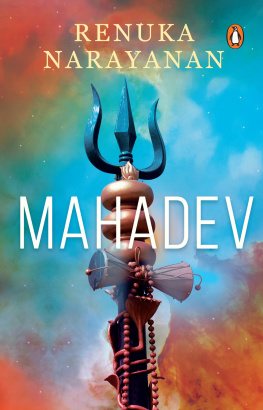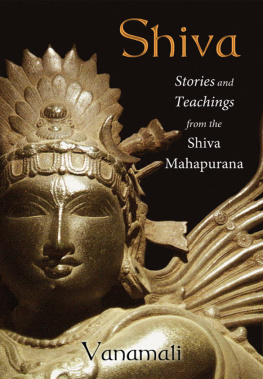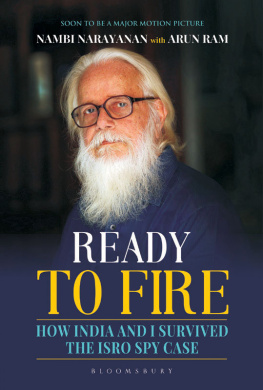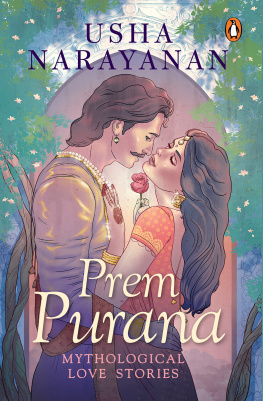Renuka Narayanan writes on religion and culture. She was the arts editor of the Indian Express, where she also wrote a column on religion for the editorial page. She was editor, Religion and Culture, Hindustan Times and the start-up director of the Indian Cultural Centre, Embassy of India, Bangkok.
She lives in Delhi.
Namas Parvati Pataye... Hara Hara Mahadeva!
1
Sadashiva Samarambham
Who is Shiva? asked the child.
Nobody knows enough to really tell, said her doting parents and grandparents. So they asked the family guru when he came by on a visit.
But he too shook his head. Nobody knew enough to really tell, even in the old days when the gods are said to have walked openly amidst us, the guru said. Tava tatvam na janami, kidrishosi, Maheshvara, I do not know the true nature of your being, nor who you are, Great Lord. Thats what it says in the Shiva Mahimna Stotram, an ancient Sanskrit hymn to Shiva, which many people recite even today. The great nineteenth-century saint Sri Ramakrishna Paramahamsa went into Samadhi, a deep yogic trance, while repeating it.
Tell me everything you know about Shiva! said the child eagerly, and catching her mothers eye, hastily added, Please, Teacher.
The guru looked gravely back at her. He remains a mystery despite the many stories about him, he said. Even the Shiva Mahimnah Stotram, which lists many stories about Shiva, says that Shiva is too big a mystery for anyone to ever fully understand. Scholars say that this hymn may have been written by a person called Grahila, who poetically calls himself Pushpadanta, a gandharva or a heavenly musician, in the hymn. He famously says:
Asita-giri-samam syat kajjalam sindhu-patre
sura-taruvara-shak ha lekhani patra-murvi
likhati yadi grhitva sharada sarva-kalam
tadapi tava gunanam isha param na yati
O Lord, even if the black mountain was ink, the ocean the inkpot, a branch of the wish-fulfilling tree the pen, the earth the writing leaf, and if, taking these, the Goddess of Learning herself writes for all eternity, you cannot be completely described.
What a picture that paints! But we can say that we know two important things about Shiva. That he is one half of God. And that he dances.
Who is the other half of God? said the child at once.
Her family smiled, knowing the delightful answer. Pleased that she had asked this question, they sat back and arranged themselves comfortably, the better to hear their guru say it.
The other half of God is Shakti. We also call her Devi, Amba, Parvati, Gauri, Lalita, Kamakshi, Chandi, Chamundi; so many wonderful names, each with a story, just like Shiva, said the guru, his face glowing with the lustre of saying the names aloud.
So Shiva is half-woman?
Or Shakti is half-man. We can see it either way, or see them together as one, the way our people usually see them, said the guru.
The child looked doubtfully at the teak-framed painting on the wall that showed Shiva and Parvati sitting side by side with their heavenly children Ganesha and Kartikeya on their laps. Then why do we see them like that? she asked.
God is actually the one Supersoul or the Paramatma. But its hard to understand that properly. It does not satisfy our human need to pray to Someone who, we hope, understands us. We need a personality, an interesting one. So, logically, we try to understand the Creator through creation. What do we see? In our lush, tropical country we see that creation is full of natural forms Aa Setu Himalaya, meaning from the southernmost shore to the highest northenmost mountains or all the way from where the three oceans meet right up to the high Himalayas. This is our land, Bharatavarshe Jambudvipe. Bharatavarshe, the land of the Bharatas; Jambudvipe, the island of the rose-apple. So it seemed natural to us that the Creator revels in form. Thats why we first saw and still see God in many wayseven as gods whom we think of as the expressions of the Supersoul.
So an image like this, of the First Family, is really like a book. Each detail in it tells a story about the powers of God. We have many images to remind us of the many powers of God. And we have rules for iconography or spiritual art, called Murti Shilpa Shastra on how to make these images of Godas a god or goddess or divine family. We also have rules for iconometry, the system of measurement for making spiritual art, called Talamana. But it was Acharya who made us see the gods clearly in the first place, said the guru.
Who is Acharya? asked the child.
Acharya means a teacher. Here I mean Adi Shankara, the great teacher who went around India years and years ago risking life and limb to make religion clear to people, said the guru.
Jaya Jaya Shankara... murmured the family in affirmation, hearing the beloved name.
The family guru nodded.
Adi Shankara was named for Shiva, who is the Adi Guru or the first teacher, he said. Adi means the first or the beginning. To come close to understanding Shiva, we need to see him the way we originally saw him, through our own eyes, and not through the eyes of others. And one of the first and most important ways we see Shiva is as Dakshinamurthi, Lord of Learning. He sits on a raised rock under a banyan tree with one leg bent at the knee. This pose is called veerasana. Four sages, the Sanakadi yogis, are clustered at his feet like students. Lord Dakshinamurthi is Shiva as our first teacher, the Gurumurti.
Meanwhile, the childs mother had Google-searched Dakshinamurthis image on her phone and silently held it out.
The guru smiled. Thats how he communicates, too, through silence. Dakshina means gift and also south. And indeed, Dakshinamurthi looks southwards to gift us moksha or soul-liberation, since the south is the direction of moksha. Almost every old Indian temple, anywhere, has an image of Dakshinamurthi on its southern wall. Look for it the next time you visit a temple.
Of the twelve most ancient Shiva temples, the one at Ujjain has the shivling facing south. Its called Mahakaleshwar, the Lord of Time. I was told it represents Dakshinamurthi, volunteered the childs grandfather.
I remember you took me there when I was about ten years old, really early in the morning, said the childs father to his father, who was pleased that he remembered.
Meanwhile, the child and the guru pored over Dakshinamurthis picture.
See how young and peaceful his face is, with the crescent moon on his head. How the old sages look up to him. Among us, even a young guru, if knowledgeable, can have older disciples. Look how his eyes are closed in deep meditation and his body is pale, with sacred ash all over it, said the guru. Hes wearing a deerskin as a wrap and holding a japmala, a veena and a sanyasis staff.

















